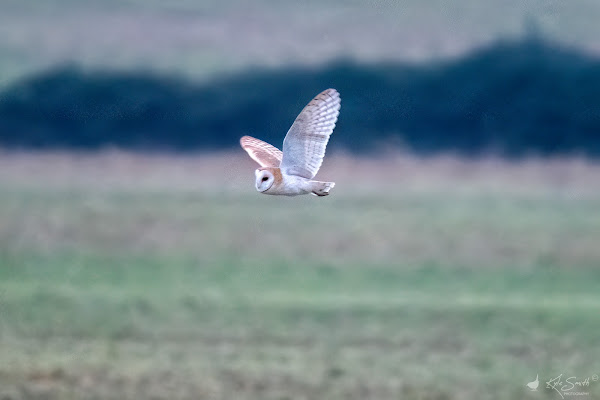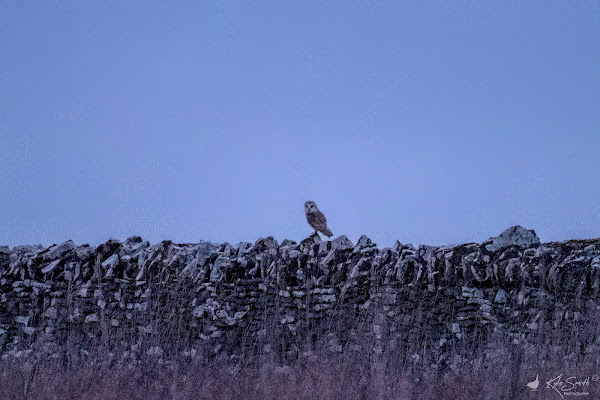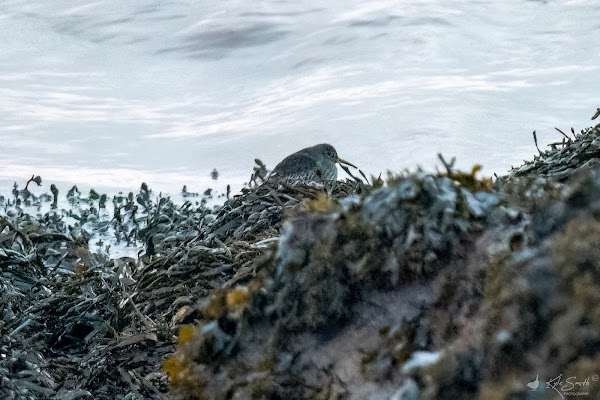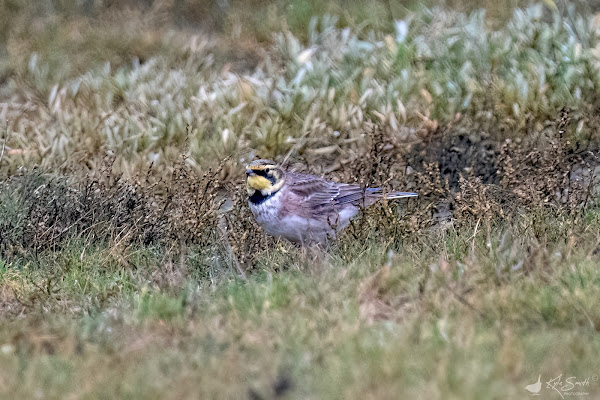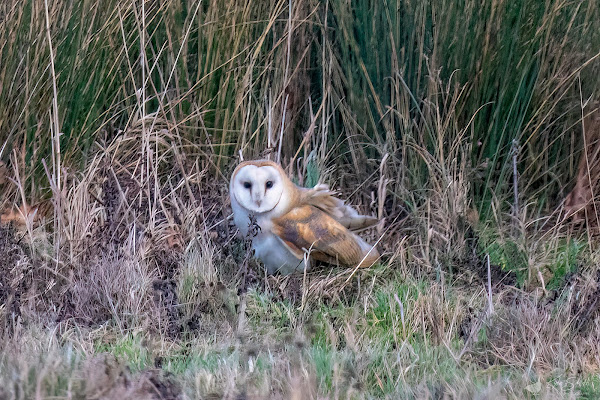I've been birding with Kevin Heath (@kev07713) for a while now and one of our biggest regrets is not going to see the penduline tits when they were in Weston-super-Mare in spring 2022. So, when reports of one in Bridgwater came out in the week there was little chance of us not going there on Saturday morning. We arrived to find a line of birders already surveying the area and a few out walking around the perimeter of the reedbed but none had seen our bird, so far. We parked up and walked around the area on the roadside scanning any movement we could see. After half an hour we decided to change location to the back pool as the bird had been seen there on several occasions and there were enough eyes on the roadside and who would likely raise the alert should they locate the bird.
We parked up on the edge of the housing estate and made our way into the park, stopping at a circular reedbed ... just in case. There was nothing to note but as we moved to leave, we picked out a Cetti's warbler which began feeding on the far perimeter - it soon disappeared without calling.
We reached a spot identified by Pagan Birder (@FegWitch) as where she had seen the bird and joined a couple of birders already staked out there. We waited and the other two eventually departed - we scanned around an I added a bullfinch to my year list. We were kept company by several stonechats that worked around the pool acting as substitutes for the penduline tit that had gone AWOL - stunning as they were, we were to be disappointed - the bird has not returned in subsequent days. We discussed what we would do next and decided to try for the Kentish plover again - high tide had just passed and there was more chance the bird would be visible on this visit.
We arrived in Burnham-on-Sea knowing that if the penduline tit was spotted we were not much further than 20 minutes away - we joined a single birder scanning with his scope from the esplanade. He had seen the bird on the island opposite so Kev started scanning to see if he could find it with the ten or so ringed plovers in view. It took a while, but Kev was eventually able to separate the bird from the other plovers and I dropped onto the scope to see it too. It wasn't easy but as others arrived from Bridgwater, we were able to help point them in the right direction, a courtesy we'd been afforded earlier. There were no signs that the small flock would make its way over and so we looked on Birdguides to if there was anything else around. We found reports of a green-winged teal at RSPB Greylake the day before and decided to visit as neither of us had been there and you just never know, we might locate the teal. These are probably the most complete Pleistocene Burtle Beds sequence in Somerset, demonstrating fluvial (or possibly glacial) gravels, marine intertidal silts and marine subtidal. A real resource to the many wildfowl that visit over the winter.
We stopped for fuel and to pick up some lunch, but it wasn't long until we pulled into the reserve car park and watched as an elderly couple filled up a feeder tray on the fence and retired to their car to watch the birds come in to feed (chaffinches and house sparrows mainly). We grabbed our kit and made our way through the entry gates. A boardwalk leads to the hide from the car park and as we stepped onto the boardwalk a couple passed coming the other way. We asked them about teal on the water and they confirmed there were hundreds - nice but we'd hoped there would be four and we would be able to identify our bird 😉. They also added that there were water rails feeding in the channel between the hides giving good views - hopefully they would continue ...
We reached a corner along our route finding an icy path and a pool of water after. I stopped to decide whether to step through the water or navigate round the mud when Kev marched through, opting for the muddy route. Wrong decision as his feet sank into the mud and up onto the bottom of his trousers - I took the water route and fared much better - thems the breaks. We pushed on and within a couple of minutes we were watching up to five water rails feeding on, and in the edge of, the icy channel. I continued to watch the water rails while Kev set up to scan the fields from the hide.
One of the birders in the hide said he'd been searching for 2½ hours and been unable to locate the teal - we suffered the same fate. We saw Cetti's warbler feeding around the same area and decided it was a great rerserve but that we were going to dip on this bird too. We considered stopping at Blagdon Lake on the way home to see the ring-necked duck, but it would be around 3.30pm by the time we got there and the bird had been recorded the previous day on the opposite side from the dam where we would park. We would stop elsewhere on the way home and see what we could find enroute.
We stopped once to view across a field containing pheasant, re-legged partridge, stock dove and woodpigeon and moved on.
We stopped again having come across some cars along the roadside - I'd previously been lucky enough to see owls here and we decided to join them. We chatted to a couple of birders, both female - they confirmed there were regular barn owls and were there to observed and photograph - one had a very tasty camera body (Nikon Z9) ... maybe one day. It took about half an hour until a barn owl appeared - a raven calling in the distance, hares and roe deer running in the field. The light was lost but I took a few photos anyway - why change the habits of a lifetime. We were lucky enough to see three barn owls and one that flew past, along and down onto the road verge. All too soon the darkness arrived, and we all packed up to leave – we had one more view of a barn owl as it landed on a wall before departing away and over the horizon.
That evening I asked my wife if it might be OK to bird again on the Sunday as Kev had already been to Eldernell (twice) to see the various owls showing there … in fact would she like to come with me. The answer was 'yes' but it would cost me lunch. I didn’t suggest too early a start so made breakfast before departing and arrived at RSPB Nene Washes (Eldernell) by 9.30am. This an area of wet grazing that usually floods each winter and attracts important numbers of waterfowl and waders, including Common Crane. Various raptors are resident or regular visitors and large flocks of ducks, swans and geese spend winter in the flooded fields, including winter migrants. There is no access onto the reserve, but there are good viewpoints along the embankment for as far as you wish to walk.
We were here to try and spot one species in particular, long-eared owl. I'd only seen this once before and at Deeping Lakes in 2022 but the view was heavily obscured (see the reports by clicking here, including my previous visit to Eldernell). As we got onto the embankment, we saw some people strolling but no one actively on a bird. I'd got directions from Kev as to the favoured roost sight for the LEOs and called him when I was close. He reminded me of the gap in the hedge I was looking for and soon located it. Almost at the same time we were joined by another birder who immediately was on a bird, primarily as it was sitting out and clearly visible with the naked eye. Above this there was a second but buried so deep there was no chance of seeing much detail - one in good was tremendous though.
We enjoyed the bird for a while with other couples joining - viewing through my scope was a real pleasure and makes a change, as much of the time I don't carry it and use Kev's - I carry bins and a camera usually, but all three on this occasion. Those without scopes were grateful for us sharing and for them to see in detail. A real upgrade on a year earlier. After this we set off to where we could see a handful of birders looking into the wood - this was our second target. On the way two swans crossed in flight and I could see they were whooper swans and new for the year.
We reached the wood and joined the group watch a tawny owl roosting in a hole. The internet is full of photos of this bird showing very well and who was I to turn up this opportunity for a detailed look at this species. We set up the scope again and took our fill.
Pleased with our day we returned to the long-eared owl and Charlotte offered to drop back to the car to pick up our tea and coffee flasks. While she was gone the owl preened and opened its eyes briefly, but not long enough for any more different photos. Charlotte returned and we enjoyed seconds of the LEO, joined now by another birder. As we chatted, he realised that we'd met before at Dunston for the red-back shrike last year - it is a small world. I also worried about what made me memorable - let’s hope it is the Scottish accent. I called Kev on Whatsapp while my phone was connected to the scope, and he could then see what we were viewing. During our chat he mentioned the position he'd seen short-eared owls in this hedge during his last visit and we set off there, accompanied by the other birder.
It took only a couple of minutes until I located a single bird in roughly the location suggested, buried deep in the hedge. There were a couple of vantage points where you could see between all the branches and twigs to see the bird's head and shoulders but never completely in the clear. Still, what a magnificent view! Crouching at an angle I was able to take a few snaps. A dozen or so people stopped to see what we were looking at and enjoyed adding this to their lists. A couple more birds were flushed to our right and relocated further along the hedge.
Eventually we tore ourselves away and made for the car as it was now approaching lunchtime - I had a promise to keep. Before packing away I saw three swans (whoopers I though) and photographed them despite being distant. Later and on review, I was to find they were in fact Bewicks and looking on reports I noticed that three Bewicks are reported on an intermittent basis over the last weeks; another new species for the year.
We repaired to the pub for lunch and then started home - too long before the bird took to the wing and didn't want to chance my arm by suggesting we hang around for a few more hours.











